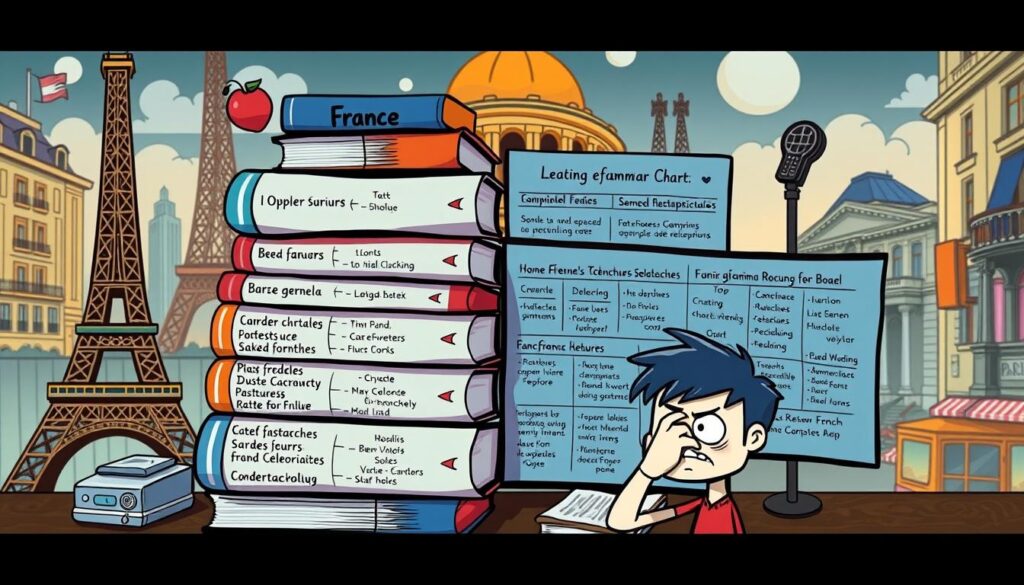Learning a new language can feel like an exciting but complex adventure. Turning your living room into a learning space is a great idea. Using language acquisition with television is not just innovative but effective. Combining leisure with education, TV as a language learning tool has proven its worth.
Your journey to language mastery can begin with your TV remote. Watching TV offers lots of engaging and entertaining content. It helps you quickly grasp a language. You learn slang and pronunciation by listening to dialogues and stories, enriched with cultural insights.
TV shows, from comedies to dramas, offer different ways to learn language. Picking the right shows can help you improve quickly. Let TV be your ally in learning—informing you, entertaining you, and teaching you.
Exploring the Possibilities: Can You Learn a Language While Watching TV?
Many wonder if you can really learn a language while watching TV. They ask if it truly helps. The answer is yes. This is especially true for kids. Kids pick up new things fast when they’re having fun.
The Practicality of Language Learning Through TV
TV blends sound and sight in a way that boosts language learning. Kids move through important steps like listening, understanding, and speaking through TV shows. This approach makes learning vocab and grammar more natural than in class.
Plus, TV’s repeating patterns, like in soap operas, help more than classes that meet less often. These patterns stick in the learner’s mind, making it easier to learn.
Combining Entertainment with Education
Mixing learning with fun works well as a teaching method. Watching favorites shows lets viewers learn new words and phrases while having fun. This way, learning stays fun, and viewers want to learn more.
Streaming services now offer shows from all over the world. This lets people explore new cultures and languages without leaving their couch.
Subtitles add to TV’s educational value. Starting with subtitles in your own language helps you understand. Then, switching to the target language improves your learning. This boosts your vocab and listening skills. Watching shows you like makes learning new words easy. So, people of any age can use TV to get better at a new language.
Understanding the Benefits of Immersion with Television
Learning a new language gets easier when you’re surrounded by it. Watching TV is a great way to do this. It lets you hear the language in action and keeps you entertained. TV is a powerful tool for education.
TV creates a setting that feels like real life. This makes it perfect for learning new languages. You get to hear the language in different situations. This helps you understand and speak it better. Shows let you hear various accents and slang, which books may miss. This real-life practice boosts your learning speed.
Moreover, watching TV helps you see how people use body language. Understanding facial expressions and gestures is key to communicating well. It also shows you the culture and social customs linked to the language. This gives you a complete learning experience.
| Technique | Description | Benefits |
|---|---|---|
| Subtitles Use | Watching with subtitles in both the native and target languages | Improves vocabulary absorption and contextual understanding |
| Repetitive Viewing | Re-watching the same content | Enhances listening skills and reinforces language structures |
| Segmented Watching | Breaking down episodes into manageable parts | Aids in detailed comprehension and allows focus on complex dialogues |
| Culturally Rich Content | Choosing content rich in cultural nuances | Exposes learners to real-life cultural scenarios, enhancing cultural understanding |
Finally, TV is a unique way to learn languages because it’s like real conversations but you can control it. Whether you’re watching new shows or old favorites, using TV for learning can really help you get better. TV brings languages to life in your learning.
Maximizing Language Acquisition with TV Programming
Integrating TV shows into your language learning plan is a smart move. It helps if you know how to watch effectively. Here’s your guide to turning fun TV time into a powerful language lesson.
Strategies for Effective Learning During Screen Time
Staying active is crucial when learning with TV shows. To boost your language skills, try these steps:
- Begin with subtitles: Watch with subtitles in your language, then switch to the language you’re learning.
- Focus on Repetition: Watch your top episodes again to better understand the words and phrases.
- Interactive Tools: Try the Learning Languages With Netflix Chrome extension. It offers dual subtitles and stops after each sentence to help you learn.
- Write and Repeat: Note down new words and phrases. Use them when you talk.
Selecting the Right TV Shows for Enhanced Learning
Finding the right TV shows is key for language success. Different types of shows can teach you different kinds of words. They also let you hear various ways of talking:
| Genre | Benefits | Example |
|---|---|---|
| Drama | Rich dialogue, complex characters | Mad Men |
| Comedy | Cultural nuances, idiomatic expressions | The Office |
| Children’s Shows | Simple language, clear pronunciation | Sesame Street |
| Documentary | Technical vocabulary, factual information | Planet Earth |
Learning a language with TV isn’t just about watching. It’s also about how you interact with what you see. By using smart strategies and picking the right shows, you can greatly improve your language skills. Plus, you’ll have fun with your favorite TV programs.
Discovering Culture Through Language Learning TV Shows
Watching language learning TV shows not only improves your language skills. It also lets you experience cultural details that textbooks often overlook. While seeing characters in their natural settings, you learn about their traditions, humor, and daily routines.
By watching TV series and movies in a new language, you learn important subtleties. You understand the mood, tone, and intentions behind interactions. This knowledge helps you get the full picture, crucial for becoming fluent.
Deciphering Social Norms and Cultural Nuances
Each TV episode lets you see how natives interact, offering real-life examples. You see how they handle gestures, etiquette, conflicts, and celebrations. These insights boost your cultural understanding and appreciation.
Connecting Language Proficiency to Cultural Comprehension
Learning language proficiency through TV shows connects words to cultural contexts. Exploring various shows, you link language to specific cultural scenarios. This transforms abstract language learning into practical communication.
Services like Netflix and Lingopie offer easy access to language-focused content. With options like adjustable speeds and interactive subtitles, learning becomes flexible. Everyone can tailor their experience, enhancing both language and cultural understanding.
The link between language proficiency and cultural comprehension is crucial. It goes beyond language. It’s about understanding people’s lives, improving how you communicate and broadening your view of the world.
The Role of Repetition and Exposure in Language Mastery
Watching TV to learn a language really works if you keep at it. You get better at understanding and speaking by hearing and seeing the language. Watching shows or movies helps you pick up on how the language sounds and its rhythms. This helps you notice small but important differences, making it easier to get fluent.
Seeing and hearing a new language on TV lets you experience it in real situations. This helps you figure out what words mean and remember them better. Even if you don’t catch every word, the visuals help you understand. Watching the same episodes or series over and over can make this even more effective. It turns a casual watching experience into a real learning opportunity.
Adding TV to your study routine makes learning feel like you’re just enjoying a show. For instance, you can find programs that match how you like to learn at LanguageYard. You’ll start to learn common words and phrases faster. Plus, you’ll get to know the culture too, thanks to seeing and hearing how people really talk.
| Segment | Numbers Engaged | Methodology |
|---|---|---|
| Story-Based Language Learning | 1,023,037 | Repeated exposure to narrative contexts |
| Certificate of Online Language Teaching Cohort | N/A | Repetition-based curriculum |
| Natural Grammar Pack Users | N/A | Exposure to grammar in use |
Repetition and exposure are key to learning a new language well. Regularly watching and listening to TV helps you learn in an effective and fun way. This method lets you understand patterns in the language while you’re enjoying the story. This makes learning both enjoyable and educational.
Incorporating TV into Your Language Learning Routine
Bringing TV into your study plan is smart and handy. By setting realistic learning objectives and utilizing subtitles effectively, your TV time becomes a learning period. A visit to sites like Netflix or AsianCrush offers a range of shows for language practice. Whether you like comedy or drama, changing how you watch TV can boost your learning.
Set clear learning goals for yourself. Maybe understand daily chats or learn new important words. Using TV and movies for language learning is handy, thanks to 15 clever tips. Start with shows that match your level, from easy children’s programs to harder thrillers. Check out IMDb for summaries to get the plot, which helps you learn before watching.
Setting Realistic Learning Objectives with Television
To start, set specific goals, like understanding everyday talk or learning frequent words. Look into tips for learning languages with TV and movies for help. Choose shows that you can grasp, from simple children’s content to complex thrillers. Reading summaries on IMDb helps grasp the storyline, aiding your learning.
Utilizing Subtitles Effectively to Foster Understanding
Subtitles help you with dialogue at first. Then, you can try switching to subtitles in the language you’re learning. This boosts your reading skills. If you’re already good, try no subtitles to improve your listening. Tools like FluentU and certain Chrome extensions help with learning. They show dual subtitles, easing your way into watching in a new language.
Writing down new words and repeating dialogues also helps. Using apps like Audacity for practice turns TV watching active. With effort, watching TV can become an engaging learning tool through cultural immersion.
Don’t stick only to traditional learning. Adding TV to your routine creatively, with tips from Language Yard, makes fluency possible and fun. Every subtitle and dialogue is a step toward your goal. So, aim high and enjoy your educational TV journey.


